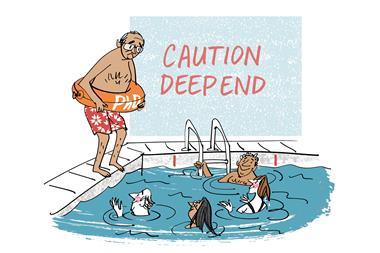Readers discuss the practical nature of chemistry and speak up for brewers
Recipe for success
I agree with Derek Lowe. Chemistry is nothing if not a practical subject. I can remember a professor of chemistry complaining about undergraduates who, when answering an exam question about the differences in properties between amines and amides, began the answer ‘I predict’. Presumably they had not seen any amines or amides.
I have since noticed some chemistry graduates whose laboratory skills were less than wonderful. The chemical community should make sure that anyone with a qualification in chemistry can do some chemistry without being a menace in the lab.
I can remember how practical chemistry transformed my life. When I started to do titrations I was slow and bad but I learnt to be systematic, to check all the glassware for cracks, to check the burette for leaks. After a while I could get an accurate result as fast as anyone. I am told that in a classical French restaurant kitchen the process of checking all the ingredients and equipment before starting is called a mise en place. Chemistry practicals taught me to apply this method to any task.
Bill Edwards FRSC CChem
Braintree, UK
Sandwich course
Regarding the letter of Mervyn Russen, from what I know about the mobility of radioactivity in soils I think that their solubility argument is not good. It is true that all metal nitrates are soluble but equally all caesium salts are soluble. Many soils contain some clay minerals, and the layered clays are able to adsorb many cations by ion exchange. One can regard a clay to be a series of slices of anionic aluminosilicate bread with plenty of potassium cations as jam between the layers. At the edges of the slices, the potassium cations can be replaced with cations such as caesium or thallium(i). The radioactive caesium from reactor accidents migrates far more slowly than water through a column of soil due to the high affinity of caesium for the clay.
Many soils lack a good means of binding anions; as a result 36Cl is very mobile in soils. The mobility of 79Se and 99Tc in soils depends on the chemistry of the soils. These elements are mobile when the soil water is oxidising, but when the soil water is reducing (as a result of bacterial action) the anions (SeO32- and TcO4-) are reduced to form less mobile forms of the elements such as TcO2. For those of you who like numbers, the Kd values for the soil at the Hanford nuclear site for americium, chlorine, caesium, lead, plutonium, selenium and technetium are about 500, 0.5, 2000, 600, 600, 15 and 0.5mlg-1. The higher the Kd the stronger the binding between the soil and the element is.
Mark Foreman CChem MRSC
Gothenburg, Sweden
Employee rights
Emma Pewsey makes the case that PhD students should be classified as employees under law, on the basis of the employment benefits that would accrue. There is an additional important aspect to such classification however: employees have important protections against treatment such as bullying, harassment and discrimination. PhD students may already be technically protected in these areas, however their only recourse is internal institutional procedures or impractical legal action in the county court. Classification as employees would allow PhD students to pursue claims at employment tribunal, a system designed as a simple and impartial arbiter of employer-employee relations.
Richard Graham
Matlock, UK
Emma Pewsey suggesting that PhD students should be employees was interesting. But she implied that the idea was radical. However, that is how I did my PhD. I was employed as a research assistant, funded by the local authority, at the Polytechnic of the South Bank (1978–81). There must be many other RSC members who also did PhDs in polytechnics, funded in the same way and working as employees.
So, while it is nice to see the idea raised in Chemistry World, I am sorry that Pewsey did not know it has been done before. In my experience, it worked very well.
John Nicholson CChem FRSC
Hampton, UK
Buried treasure
The excellent article on the use of polyoxometalates (POMs) in transuranic element chemistry prompted me to search out my ancient PhD thesis. I was not imagining it! I synthesised the first actinide POM way back in 1969. Not transuranic – no possibility of that – but at least uranic: dark brown Cs10[U(iv) (PW11O39)2].17H2O (and the SiW11 analogue). Unfortunately they didn’t make the cut for our paper on the lanthanide complexes of POMs; I wrote in my thesis ‘stable U(iv) containing species are not particularly unusual and the complexes were not studied further’. This should be a warning to young researchers – publish everything, even if you think it is not particularly unusual – it might become fashionable in 50 years’ time!
Robert Peacock CChem FRSC
Glasgow, UK
Cheers to brewers!
Mike Sutton’s article on Francis Aston’s discovery of mass spectrometry contains the somewhat unfortunate sentence ‘An impressive career trajectory for a former brewery chemist!’ The brewing industry was one of the first to embrace scientific methods, including the use of thermometers and hydrometers. The Kjeldahl method for total nitrogen, the concept and scaling of pH and various methods for studying proteins came from a brewing lab. Let’s not forget Louis Pasteur’s work on beer, William Gosset (of Student’s t-test fame) who worked for Guinness. James Prescott Joule was a brewer. Best not to be too snooty about brewing chemistry, especially as so many chemists enjoy the product.
Ron Gardner FRSC
Upton Snodsbury, UK
Chemistry World welcomes letters, which should be concise (normally fewer than 300 words) and timely. Those selected for publication are subject to editing for clarity and length. Letters should be marked ‘for publication’ and sent to chemistryworld@rsc.org
We do not routinely acknowledge letters.












No comments yet